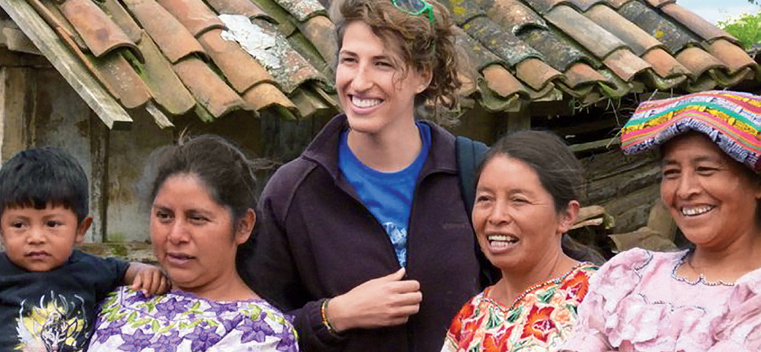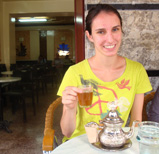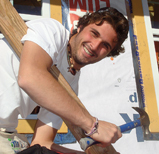
Give Me a Break
Sean Hargadon is senior editor of Northwestern magazine.
Tell us what you think. E-mail comments or questions to the editors at letters@northwestern.edu.
Ever wonder about those strange designations we use throughout Northwestern to identify alumni of the various schools of the University? See the complete list.
Find Us on Social Media
Students who take a gap year before college to follow their passions arrive at Northwestern well focused.
Leah Varjacques had spent the summer before her high school senior year on a six-week language and culture immersion program in Guatemala and felt inspired, and she wanted more. So, with her Northwestern acceptance in hand, she cooked up a plan to defer her enrollment and take a gap year — a structured break from formal education between high school and college — to dig deeper into Guatemala.
“I felt that this was a moment in my life when I had time to take off,” says Varjacques, a sophomore journalism major from New Rochelle, N.Y. “I had done a really intense high school path and worked really hard, and I thought, ‘I can do this. I can take time off, go back to this place that I love and explore. I don’t know when I’ll be able to do this again. I don’t want to think about what I’m going to do in four years. This experience could change what I want to do in four years.’ ”
Her father, Gerard, did not see it the same way. “I thought, ‘Come on. You had your trip. That was great. Now you want to go away again? You must be kidding me.’ ”
Born outside of Paris, Varjacques moved to the United States at 6 and attended the French American School of New York. She says the gap year was a foreign concept to her French family.
To sell her corporate executive father on the idea, Varjacques presented her plan in a PowerPoint highlighting the benefits of a gap year, the countries she would like to visit, the safety of the program’s sponsor organization and her financial contribution to the cost of the program.
Gerard, COO of Traiana, a software company that serves financial institutions, was impressed. “It was funny. It was concise. It was right to the point. And it made me think, ‘OK, she seems to be really very serious about it.’ She already wanted to study journalism and international relations, so it made sense.”
Varjacques is one of a handful of Northwestern undergraduates who have taken a gap year to increase self-awareness, learn about other cultures and experiment with possible careers through traveling, volunteering, interning or working. She spent most of her gap year in Guatemala with Where There Be Dragons, which offers international education programs focused on global citizenship and service learning. During the first portion of her gap year she studied the roots of rebellion in Central America, learning about the historical reasons for and the aftermath of civil wars and revolutions in Guatemala, El Salvador and Nicaragua through homestays, meetings with grassroots organizations and conversations with survivors.
She spent the second half of the year in Quetzaltenango in southwest Guatemala, where she wrote and translated articles for a bilingual magazine that focused on development and human rights issues. She also worked with the mayor’s Municipal Office of Women, which offered job and literacy training and sexual education to indigenous women in surrounding impoverished communities.
“I think a gap year provides focus and direction about what you want to do,” says Varjacques, who immediately got involved with the Northwestern University Conference on Human Rights and started reporting for The Protest, a student-run social justice magazine (see “Alternatives,” fall 2008), when she arrived at Northwestern. “A lot of my friends were changing their majors so many times. I feel like knowing what you’re interested in right off the bat makes you take advantage of the opportunities here a lot more quickly.”
Her father has come around on the idea too. He says the gap year was a catalyst for his daughter. “It really shaped what she wants to do and how she wants to use college to serve her interests. Leah was better armed after the gap year to cope with college.”
Students often take a gap year to re-examine their goals or recover from educational burnout, according to Karl Haigler and Rae Nelson, who wrote the 2005 book Gap Year Advantage (St. Martin’s Press). Studies have found that students who take a gap year are more motivated and better at planning and task management than their peers.
“You want to have students who come into your institution ready to take advantage of all that you have to offer,” says Lois Trautvetter, an associate professor and director of Northwestern’s master’s program in Higher Education Administration and Policy. “So if it’s a matter of having some students take a gap year in order to ready themselves, I think any institution should be amenable to that.”
It’s not a new phenomenon — the Center for Interim Programs, one of the first gap-year counseling companies, launched in 1980. But it is rare in the United States. Just 1.2 percent of first-time college freshmen took a gap year in 2011, according to the Higher Education Research Institute.
Northwestern, with an average incoming class of around 2,000 students, receives 25 to 30 deferral requests every year and grants almost all of them, says Chris Watson, the University’s dean of undergraduate admission.
For more than 30 years Harvard College has invited students to consider a gap year in its acceptance letter, and every year 50 to 70 students (out of a class of 1,600) take the university up on the offer. Princeton University and the University of North Carolina at Chapel Hill recently launched university-sponsored gap-year programs.
“Colleges find that there are incredible benefits from having students who have had a gap-year experience,” says Linda Connelly, a post–high school counselor at New Trier High School in Winnetka, Ill. “These young people can offer so much more in the classroom. They have a better sense of what they want to do in college. They’re more interesting. They’re more mature.”

Kelsey Ott
Kelsey Ott, a sophomore international studies and journalism major from Darien, Conn., split her gap year between Morocco and the South Pacific. During her homestay in Fez, Ott volunteered at a center for street kids and participated in her host family’s Eid al-Adha celebration, including the ritual sacrifice of a goat. In the South Pacific she worked on an organic farm in New Zealand and helped build a sidewalk in a swampy village in Fiji. Ott says her gap-year experience confirmed her passion for international studies.
“I was always interested in foreign countries,” says Ott, who also studied public health in Cuba through Northwestern’s Office of International Program Development last summer. “My gap year definitely opened me up to the experience of being with different cultures. Now I’m interested in working abroad as a journalist after college.”
That’s another benefit of the gap year, says Trautvetter. “Students these days feel enormous pressure to know what they are going to major in. And so for a student who’s not quite sure about that, a gap year, if used effectively, can help them focus on what they might want to do.”
Bob Clagett, former dean of admission at Middlebury College and a former senior admission officer at Harvard College, found additional educational benefits when he analyzed the academic success of students who had taken a gap year. Clagett looked at how gap-year students performed academically relative to how they were predicted to perform based on their academic rating, a university-specific tool used in the admission process to quantify academic potential. Gap-year students at Middlebury had GPAs that were up to .2 higher on a 4-point scale than the rating would have predicted.
“This shows a really clear pattern of overachievement, and the positive effect lasted throughout the students' four years,” says Clagett. “The gap year is clearly a concept whose time has come,” he adds. “We have to try to get these kids who have been so highly programmed for so long to do something different, to step off the treadmill.”
It’s an idea that’s growing in popularity too. Connelly started offering small gap-year fairs, with just four or five presenters, to her students at New Trier in 1998. Now the school’s gap fair includes 35 program providers and draws more than 400 high school students from throughout Chicago and across the region. The Chicago event is one of more than 30 USA Gap Year Fairs held across the country.
Gap years come in all forms — from costly, structured international immersion programs to build-it-yourself, personalized volunteer and travel trips. Some programs cost as much as a year of tuition — upwards of $30,000, though some organizations provide need-based financial aid. Varjacques’ three-month roots of rebellion program in Central America with Where There Be Dragons, for example, cost roughly $12,000 for land and air travel. City Year and AmeriCorps also offer gap-year volunteer programs that include housing and an educational stipend.
“Everyone is well served by taking time off,” adds Clagett. “It doesn’t have to be an upper–middle class or top 2 percent kind of phenomenon. If students can be a little more creative, they can do all kinds of interesting things and not have it cost a lot of money.”

Ben Kemper. Photo by Rafi Letzter (J15)
Sophomore Ben Kemper experienced his gap year close to the comforts of home in Boise, Idaho. A semi-professional storyteller since second grade, Kemper had planned to develop a stock of stories during his gap year. But after he read Tim Egan’s The Big Burn: Teddy Roosevelt and the Fire that Saved America, Kemper scrapped his plans and went to work researching the great fire of 1910 that raged through the panhandle of northern Idaho and western Montana. He set out to create one story “covering every detail of the fire and the lives it affected.”
With a grant from the Idaho Humanities Council, Kemper spent months poring over the book and then went on a road trip with his sister to towns like Coeur d’Alene and Wallace, Idaho, “areas that were affected and in some cases completely destroyed by the fire,” Kemper says.
“The highlight of our pilgrimage was visiting a little tunnel outside of Wallace where Edward Pulaski, a forest ranger, sheltered 50 miners in a little space — perhaps 200 feet long and five feet tall. Pulaski stationed himself at the front of the tunnel, wrapped his hands in wet blankets and beat out the flames from the inferno beyond. And he kept those men alive.”
Pulaski — namesake of the U.S. Forest Service’s official tool, a long straight shaft with an ax on one end and a mattock on the other — became one of the primary characters in Kemper’s hourlong story, which he presented at the Idaho State Historical Society in Boise and at libraries, hotels and historical centers throughout northern Idaho and western Montana. (Read an excerpt from Kemper's story of the great fire.)
“The people there were extremely moved by it because they had grown up with this history,” Kemper says. “And they said that I had done a very good job of describing not only the kind of men and women who were trapped there but also, and this was very important to me, the feeling of being caught in a forest fire and its mechanics and just how fast and furious it can be.”
Kemper, a theater major who dreams of becoming a Shakespearean actor and a regular on the national storytelling circuit, says the gap year is a good idea for most students. “If they have a general idea, if they want to go off and travel the world or do some good — and it doesn’t have to be terribly structured, so long as they are working toward something — I would highly suggest taking a gap year.”

Demetri Elias
Junior Demetri Elias decided he wanted to take a gap year when he was just a high school sophomore. Over the next 2 1/2 years he cobbled together close to $9,000 by stashing away his birthday and Christmas money, working construction and consciously limiting his social outings. In September 2009 he set out from his home in New York City for a gap year of adventure. He lived on a beach for 30 days in Chania, Crete, tracking hatchlings for Archelon, Greece’s sea turtle protection society. He helped coach youth soccer programs in Accra, Ghana, with the international volunteer organization Projects Abroad. Elias built houses in New Orleans’ 9th Ward with Habitat for Humanity and volunteered with the Cultural Olympiad, a celebration of art and culture that occurred in conjunction with the 2010 Winter Olympics in Vancouver, British Columbia. He ended his whirlwind world tour by working with the Missionaries of Charity at a hospice and an orphanage for mentally and physically disabled children in Calcutta, India.
“Out of all the things I did, that was the work that most needed to be done,” says Elias, who made the decision to study history and archaeology while on his gap year. “Gap year puts everything in perspective,” he adds. “Small things that people get so worked up about, myself included, are just not important at all. On my gap year, people who had nothing were so generous, and I just want to emulate that.”



 Facebook
Facebook Twitter
Twitter Email
Email


